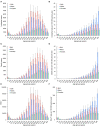Burden of kidney cancer and attributed risk factors in China from 1990 to 2019
- PMID: 36589951
- PMCID: PMC9800998
- DOI: 10.3389/fpubh.2022.1062504
Burden of kidney cancer and attributed risk factors in China from 1990 to 2019
Abstract
Background: The changing trends and risk-attributed burdens of kidney cancer in China are unknown. Therefore, this study aimed to describe the latest status and trends of kidney cancer burden in China and its associated risk factors.
Methods: The absolute numbers and rates of the incidence, deaths, and disability-adjusted life-years (DALYs) of kidney cancer in China were extracted from the Global Burden of Disease 2019 platform. Overall burden and burden attributed to smoking and high body mass index (BMI) were described. Average annual percent change (AAPC) was calculated to describe trend analyses from 1990 to 2019 using the Joinpoint regression program.
Results: In 2019, 59,827 new cases, 23,954 deaths, and 642,799 DALYs of kidney cancer occurred in China, of which men accounted for 71.1, 70.5, and 72.0%, and the population aged ≥55 years accounted for 58.9, 77.9, and 60.1%, of new cases, deaths, and DALYs, respectively. From 1990 to 2019, the age-standardized incidence rate (per 100,000 person-years) increased from 1.16 in 1990 to 3.21 in 2019, with an AAPC of 3.4% (95% confidence interval [CI]: 3.1-3.8%, p < 0.05); the mortality rate increased from 0.70 to 1.27, with an AAPC of 2.1% (1.5-2.3%, p < 0.05); and the DALY rate increased from 0.70 to 1.27, with an AAPC of 2.1% (1.5-2.3%, p < 0.05). In 2019, the proportions of DALYs attributed to smoking and high BMI were 18.0% and 11.1%, respectively, and the DALY rates attributed to both smoking and high BMI increased from 1990 to 2019, with AAPC of 2.9% (2.6-3.3%, p < 0.05) and 4.8% (4.2-5.4%, p < 0.05), respectively.
Conclusion: The kidney cancer burden in China has continued to grow over the recent three decades, with a severe burden among older adults and men. Therefore, timely preventive interventions for modifiable risk factors are required.
Keywords: burden of disease; epidemiology; kidney cancer; risk factor; trends.
Copyright © 2022 Wang, Wang, Wang and Xie.
Conflict of interest statement
The authors declare that the research was conducted in the absence of any commercial or financial relationships that could be construed as a potential conflict of interest.
Figures



References
MeSH terms
LinkOut - more resources
Full Text Sources
Medical

